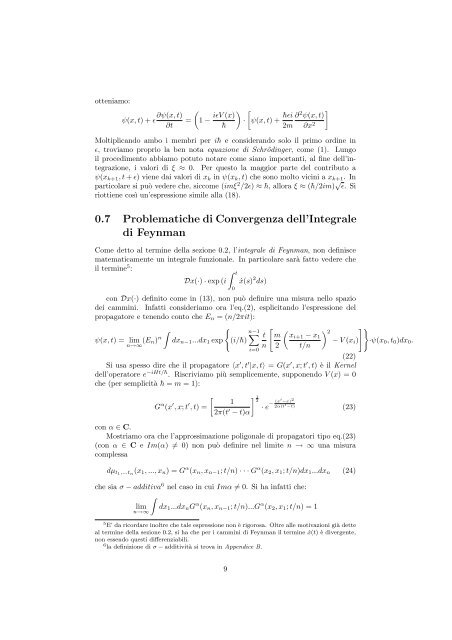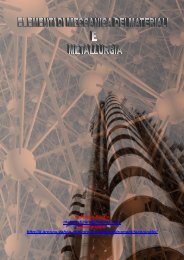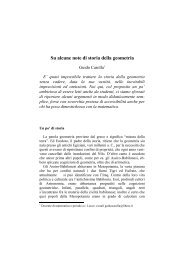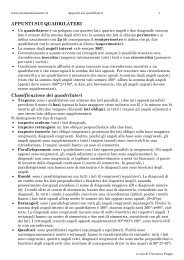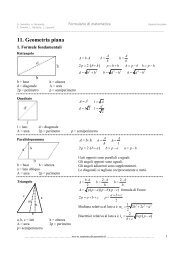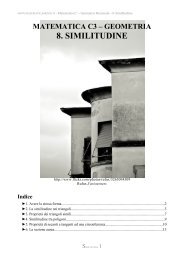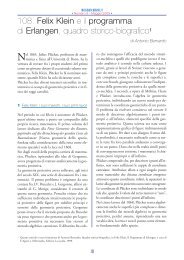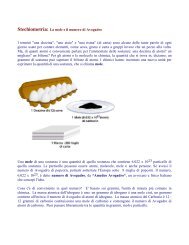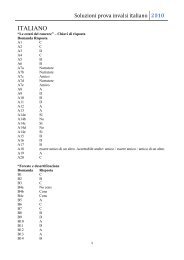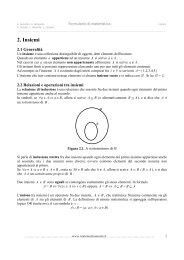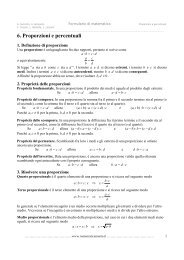Scarica la tesi Integrale di Feynman sui Cammini e Processi Stocastici
Scarica la tesi Integrale di Feynman sui Cammini e Processi Stocastici
Scarica la tesi Integrale di Feynman sui Cammini e Processi Stocastici
You also want an ePaper? Increase the reach of your titles
YUMPU automatically turns print PDFs into web optimized ePapers that Google loves.
otteniamo:<br />
∂ψ(x, t)<br />
ψ(x, t) + ɛ =<br />
∂t<br />
<br />
1 −<br />
<br />
iɛV (x)<br />
· ψ(x, t) +<br />
¯h<br />
¯hɛi<br />
2m<br />
∂2ψ(x, t)<br />
∂x2 <br />
Moltiplicando ambo i membri per i¯h e considerando solo il primo or<strong>di</strong>ne in<br />
ɛ, troviamo proprio <strong>la</strong> ben nota equazione <strong>di</strong> Schrö<strong>di</strong>nger, come (1). Lungo<br />
il proce<strong>di</strong>mento abbiamo potuto notare come siano importanti, al fine dell’integrazione,<br />
i valori <strong>di</strong> ξ ≈ 0. Per questo <strong>la</strong> maggior parte del contributo a<br />
ψ(xk+1, t + ɛ) viene dai valori <strong>di</strong> xk in ψ(xk, t) che sono molto vicini a xk+1. In<br />
partico<strong>la</strong>re si può vedere che, siccome (imξ 2 /2ɛ) ≈ ¯h, allora ξ ≈ (¯h/2im) √ ɛ. Si<br />
riottiene così un’espressione simile al<strong>la</strong> (18).<br />
0.7 Problematiche <strong>di</strong> Convergenza dell’<strong>Integrale</strong><br />
<strong>di</strong> <strong>Feynman</strong><br />
Come detto al termine del<strong>la</strong> sezione 0.2, l’integrale <strong>di</strong> <strong>Feynman</strong>, non definisce<br />
matematicamente un integrale funzionale. In partico<strong>la</strong>re sarà fatto vedere che<br />
il termine 5 :<br />
t<br />
Dx(·) · exp (i ˙x(s)<br />
0<br />
2 ds)<br />
con Dx(·) definito come in (13), non può definire una misura nello spazio<br />
dei cammini. Infatti consideriamo ora l’eq.(2), esplicitando l’espressione del<br />
propagatore e tenendo conto che En = (n/2πit):<br />
<br />
n<br />
ψ(x, t) = lim (En)<br />
n→∞<br />
<br />
<br />
n−1 <br />
<br />
t m xi+1 − x1<br />
dxn−1...dx1 exp (i/¯h)<br />
n 2 t/n<br />
i=0<br />
2<br />
− V (xi)<br />
(22)<br />
Si usa spesso <strong>di</strong>re che il propagatore 〈x ′ , t ′ |x, t〉 = G(x ′ , x; t ′ , t) è il Kernel<br />
dell’operatore e −iHt/¯h . Riscriviamo più semplicemente, supponendo V (x) = 0<br />
che (per semplicità ¯h = m = 1):<br />
G α (x ′ , x; t ′ , t) =<br />
<br />
1<br />
2π(t ′ − t)α<br />
1<br />
2<br />
· e − (x′ −x) 2<br />
2α(t ′ −t) (23)<br />
con α ∈ C.<br />
Mostriamo ora che l’approssimazione poligonale <strong>di</strong> propagatori tipo eq.(23)<br />
(con α ∈ C e Im(α) = 0) non può definire nel limite n → ∞ una misura<br />
complessa<br />
dµt1,...tn(x1, ..., xn) = G α (xn, xn−1; t/n) · · · G α (x2, x1; t/n)dx1...dxn<br />
che sia σ − ad<strong>di</strong>tiva6 nel caso in cui Imα = 0. Si ha infatti che:<br />
<br />
lim<br />
n→∞<br />
dx1...dxnG α (xn, xn−1; t/n)...G α (x2, x1; t/n) = 1<br />
(24)<br />
5 E’ da ricordare inoltre che tale espressione non è rigorosa. Oltre alle motivazioni già dette<br />
al termine del<strong>la</strong> sezione 0.2, si ha che per i cammini <strong>di</strong> <strong>Feynman</strong> il termine ˙x(t) è <strong>di</strong>vergente,<br />
non essendo questi <strong>di</strong>fferenziabili.<br />
6 <strong>la</strong> definizione <strong>di</strong> σ − ad<strong>di</strong>tività si trova in Appen<strong>di</strong>ce B.<br />
9<br />
<br />
·ψ(x0, t0)dx0.


